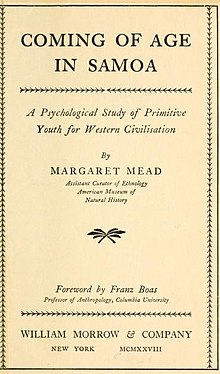Coming of Age in Samoa

Original title page (1928).
|
|
| Author | Margaret Mead |
|---|---|
| Country | United States |
| Language | English |
| Genre | Samoan culture and society |
| Publisher | William Morrow and Co. |
|
Publication date
|
1928 |
| Media type | Print (Paperback) |
| Pages | 297 |
Coming of Age in Samoa is a book by American anthropologist Margaret Mead based upon her research and study of youth – primarily adolescent girls – on the island of Ta'u in the Samoan Islands. First published in 1928, the book launched Mead as a pioneering researcher and as the most famous anthropologist in the world. Since its first publication, Coming of Age in Samoa was the most widely read book in the field of anthropology until Napoleon Chagnon's Yanomamö: The Fierce People overtook it. The book has sparked years of ongoing and intense debate and controversy on questions pertaining to society, culture, and science. It is a key text in the nature and nurture debate, as well as in discussions on issues relating to family, adolescence, gender, social norms, and attitudes. Although Mead's work has been very influential some of her most significant claims about Samoan culture have been criticized and contradicted by subsequent research. Particularly the anthropologist Derek Freeman has contested many of Mead's claims, and argued that she was hoaxed into counterfactually believing that Samoan culture had more relaxed sexual norms than Western culture.
In the foreword to Coming of Age in Samoa, Mead's advisor, Franz Boas, wrote:
Courtesy, modesty, good manners, conformity to definite ethical standards are universal, but what constitutes courtesy, modesty, good manners, and definite ethical standards is not universal. It is instructive to know that standards differ in the most unexpected ways.
Boas went on to point out that, at the time of publication, many Americans had begun to discuss the problems faced by young people (particularly women) as they pass through adolescence as "unavoidable periods of adjustment". Boas felt that a study of the problems faced by adolescents in another culture would be illuminating.
Mead introduces the book with a general discussion of the problems facing adolescents in modern society and the various approaches to understanding these problems: religion, philosophy, educational theory and psychology. She discusses various limitations in each approach and then introduces the new field of anthropology as a promising alternative science based on analyzing social structures and dynamics. She contrasts the methodology of the anthropologist with other scientific studies of behavior and the obvious reasons that controlled experiments are so much more difficult for anthropology than other sciences. For this reason her methodology is one of studying societies in their natural environment. Rather than select a culture that is fairly well understood such as Europe or America she chooses South Sea island people because their culture is radically different from western culture and likely to yield more useful data as a result. However, in doing so she introduces new complexity in that she must first understand and communicate to her readers the nature of South Sea culture itself rather than delve directly into issues of adolescence as she could in a more familiar culture. Once she has an understanding of Samoan culture she will delve into the specifics of how adolescent education and socialization are carried out in Samoan culture and contrast it with western culture.
...
Wikipedia
